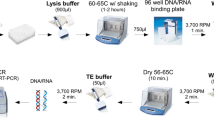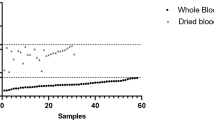Abstract
As parasitological or microscopic method is the gold standard and the best method for diagnosis of malaria, so fixed Geimsa-stained blood slides in the form of thick and thin blood smears are the most important data collections of malaria, especially historical slides. The parasites are dead but their DNA is valuable for many molecular biologic researches. A simple and efficient method for catching and extraction malaria parasites' DNA with a desired yield from dried and stained blood on slides is the first and major step. Introduction of an applicable, efficient and inexpensive DNA catching method and assessment of its performance in following molecular applications was the main objective of present study.

Similar content being viewed by others
References
Brown AE, Kain KC, Pipithkul J, Webster HK (1992) Demonstration by the polymerase chain reaction of mixed Plasmodium falciparum and P. vivax infections undetected by conventional microscopy. Trans R Soc Trop Med Hyg 86:609–612
Carrasquilla G et al (2000) Epidemiologic tools for malaria surveillance in an urban setting of low endemicity along the Colombian Pacific coast. Am J Trop Med Hyg 62:132–137
Ebrahimzadeh A, Polshakan M, Qureshi M, Sharifi I (2006) Reliable DNA extraction on historical malaria negative smears conducted to nested PCR in South-East of Iran. Biotechnology 5:353–357
Edoh D, Steiger S, Genton B, Beck HP (1997) PCR amplification of DNA from malaria parasites on fixed and stained thick and thin blood films. Trans R Soc Trop Med Hyg 91:361–363
Eskandarian AA, Keshavarz H, Mahboudi F (2003) Pyrimethamine and proguanil resistance-conferring key mutations in dehydrofolate reductase gene of Plasmodium falciparum isolates from Iran. Iranian J Publ Health 32(4):8–12
Gilles H (1993) Diagnostic methods in malaria. In: Gilles H, Warrel D (eds) Bruce-Chwatt’s essential malariology, 3rd edn. Edward Arnold, London, pp 78–95
Imwong M et al (2003) Novel point mutations in the dihydrofolate reductase gene of Plasmodium vivax: evidence for sequential selection by drug pressure. Antimicrob Agents Chemother 47:1514–1521
John S, Sundarsanam A, Sitaram U, Moody A (1998) Evaluation of OptiMAL®, a dipstick test for the diagnosis of malaria. Ann Trop Med Parasitol 92:621–622
McMichael T, Montgomery H, Costello A (2012) Health risks, present and future, from global climate change. BMJ 344:e1359. doi:10.1136/bmj.e1359
Payne D (1988) Use and limitations of light microscopy for diagnosing malaria at the primary health care level. Bull World Health Organ 66:621–626
Scopel KK, Fontes CJ, Nunes AC, Horta MF, Braga EM (2004) High prevalence of Plamodium malariae infections in a Brazilian Amazon endemic area (Apiacas-Mato Grosso state) as detected by polymerase chain reaction. Acta Trop 90:61–64
Snounou G (1996) Detection and identification of the four malaria parasite species infecting humans by PCR amplification. Methods Mol Biol 50:263–291
Snounou G, Viriyakosol S, Jarra W, Thaithong S, Brown KN (1993) Identification of the four human malaria parasite species in field samples by the polymerase chain reaction and detection of a high prevalence of mixed infections. Mol Biochem Parasitol 58:283–292
Sultan DM, Khalil MM, Abdouh AS, Doleh WF, Al Muthanna AA (2009) Imported malaria in United Arab Emirates: evaluation of a new DNA extraction technique using nested PCR. Korean J Parasitol 47:227–233. doi:10.3347/kjp.2009.47.3.227
World Health Organization, 1996. Fact Sheet No. 94. Geneva:World Health Organization
Zakeri S, Najafabadi ST, Zare A, Djadid ND (2002) Detection of malaria parasites by nested PCR in south-eastern, Iran: evidence of highly mixed infections in Chahbahar district. Malar J 1:2
Acknowledgments
Our appreciation and thanks to Mr Masoud Yarian, head of Minab malaria lab for supporting samples collection, Isfahan University of Medical Sciences and Islamic Azad University of Falavarjan Branch for some support of this study.
Author information
Authors and Affiliations
Corresponding author
Rights and permissions
About this article
Cite this article
Eskandarian, A.A., Moradi, S. & Abedi, S. A simple, efficient and inexpensive method for malaria parasites’ DNA catching from fixed Giemsa-stained blood slides. J Parasit Dis 40, 833–837 (2016). https://doi.org/10.1007/s12639-014-0587-3
Received:
Accepted:
Published:
Issue Date:
DOI: https://doi.org/10.1007/s12639-014-0587-3




